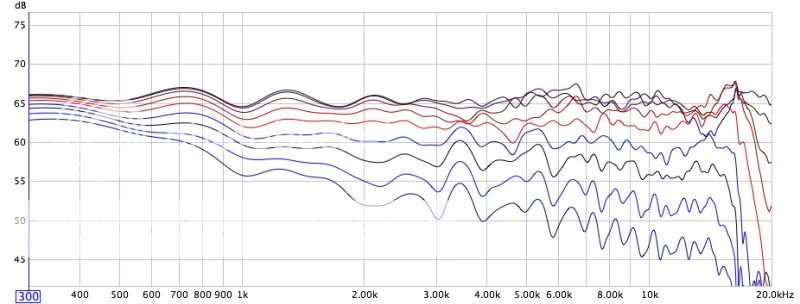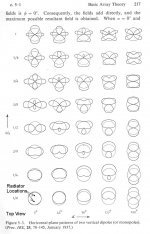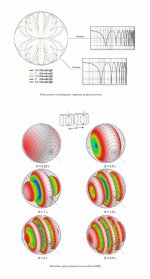snip As much as people get excited about the concept of "damping" in the end you are just allowing the output voltage to follow the shape of the impedance curve (with low damping) or forcing flat voltage (with high damping). Ain't nothin' in the amplifier "reaching out and grabbing the woofer cone".
snip
David
Respectfully, with motional feedback (or using current feedback configured right), the amp output drive is the opposite of the impedance curve. So where the cone lets go at resonance and in errors, the amp grabs it. How about that!
As significant, the amp "pushes" the driver below resonance in sealed enclosures as much as you want because, like I said, it naturally provides the opposite of the impedance curve. Now wouldn't that be grand?
Ummm, pity you can't use it with bass reflex and other tuned boxes (TH??) for reasons too obvious to dwell on.
Yes, had one of those Fishers. One of the most beautiful purple and gold 6L6 amps, if I recall. Like I said, cousin to true motional feedback.
Last edited:
This concept seems very interesting. Most speakers have very peaky impedance curves, is there any data showing how the harmonics of the amp hooked to a real speaker looks like? and how it varies with different speakers?Respectfully, with motional feedback (or using current feedback configured right), the amp output drive is the opposite of the impedance curve. So where the cone lets go at resonance and in errors, the amp grabs it. How about that!
As significant, the amp "pushes" the driver below resonance in sealed enclosures as much as you want because, like I said, it naturally provides the opposite of the impedance curve. Now wouldn't that be grand?
Ummm, pity you can't use it with bass reflex and other tuned boxes (TH??) for reasons too obvious to dwell on.
Yes, had one of those Fishers. One of the most beautiful purple and gold 6L6 amps, if I recall. Like I said, cousin to true motional feedback.
This concept seems very interesting. Most speakers have very peaky impedance curves, is there any data showing how the harmonics of the amp hooked to a real speaker looks like? and how it varies with different speakers?
The impedance curve (or more precisely, the back EMF component of the impedance) of the driver is the motion of the voice coil, as far as I know. And for sealed enclosures and with no passive crossovers getting in the way, represents the amount of sound down to some frequency depending on driver size (which I can't remember from reading Olson or Beranek 45 years ago). Driver output below that dimension where radiation resistance declines is still tied to VC motion, but needs correction.
If the back EMF deviates from the signal, you've got error AND you've got an error signal to feed back towards the pre-amp.
Not a perfect idea but what kind of feedback would anybody else propose if you aren't working with special drivers?
The Rythmik Audio concept (which uses special drivers with a custom VC winding) is a bit different but the purpose is the same. Their website explains the idea pretty well.
Should a woofer have a good (wideband) pulse response?
I ask you this: what would the hypothetical guest from Mars say if you told them, "Frankly, we don't feel any need for feedback to correct our lousiest most distorted component."
Last edited:
I have measured amplifiers hooked to speakers. Although currently I don't have enought samples to conclude anything, but I do find that any wavyness in the impedance will change the response of the amplifiers I have measured. Have you also measured such effect on preamp? My instinct about that is the influence is conducted more through the ground connection.
But I am more interested in the concept you previously mentioned, and wish to know what kind of measured data is available.
But I am more interested in the concept you previously mentioned, and wish to know what kind of measured data is available.
The impedance curve (or more precisely, the back EMF component of the impedance) of the driver is the motion of the voice coil, as far as I know. And for sealed enclosures and with no passive crossovers getting in the way, represents the amount of sound down to some frequency depending on driver size (which I can't remember from reading Olson or Beranek 45 years ago). Driver output below that dimension where radiation resistance declines is still tied to VC motion, but needs correction.
If the back EMF deviates from the signal, you've got error AND you've got an error signal to feed back towards the pre-amp.
Not a perfect idea but what kind of feedback would anybody else propose if you aren't working with special drivers?
The Rythmik Audio concept (which uses special drivers with a custom VC winding) is a bit different but the purpose is the same. Their website explains the idea pretty well.
Should a woofer have a good (wideband) pulse response?
I ask you this: what would the hypothetical guest from Mars say if you told them, "Frankly, we don't feel any need for feedback to correct our lousiest most distorted component."
How about measure the distance from mid to tweet?
Attached is a handy little chart which shows radiation pattern from two sources separated by a fixed wavelength and operated at various phase relationships.
For all you who use crossovers from mid to tweet at frequencies above about 1200Hz, these graphs of polar response of two radiators should be pretty interesting. The graphs assume same amplitude. These graphs are valid on up through the crossover region until one driver is more than 3dB down from the other driver. Within 3dB these graphs will pretty well be it.
As anyone can see its becomes quite the mess if driver separation is more than 1/2 wavelength at any frequency. So much for so many who try for the "controlled directivity" system. Many many speakers have this "drivers to far separated" feature. Yuk!
=SUM
Attached is a handy little chart which shows radiation pattern from two sources separated by a fixed wavelength and operated at various phase relationships.
For all you who use crossovers from mid to tweet at frequencies above about 1200Hz, these graphs of polar response of two radiators should be pretty interesting. The graphs assume same amplitude. These graphs are valid on up through the crossover region until one driver is more than 3dB down from the other driver. Within 3dB these graphs will pretty well be it.
As anyone can see its becomes quite the mess if driver separation is more than 1/2 wavelength at any frequency. So much for so many who try for the "controlled directivity" system. Many many speakers have this "drivers to far separated" feature. Yuk!
=SUM
Attachments
Been looking for the link to this software. Here it is. Does crossovers with FIR filters and much more. Planning on setting one of these up myself. Everyone says it works very well!
(((acourate)))® - Room Correction, Speaker Optimization and Sound Improvement
🙂=SUM
(((acourate)))® - Room Correction, Speaker Optimization and Sound Improvement
🙂=SUM
SUM, I think all of us doing this sort of thing(or designing any speakers) are well aware of the issue. Can't really call it a make or break problem, just something to work with.
This applet is nice for visualization w/o phase differences:
http://www.falstad.com/interference/index_ap.html
Nothing beats measuring the final product,
Dan
This applet is nice for visualization w/o phase differences:
http://www.falstad.com/interference/index_ap.html
Nothing beats measuring the final product,
Dan
Last edited:
It is a handy chart and it shows quickly the problems associated high crossover points. Why build a speaker with a known obvious problem of excessive driver separation? Really, why go down that path? I posted this because from the discussion thread it was clear a lot of people do not get this and the chart makes it easy. That app is cool.
What about that software? Very cool to me.
What about that software? Very cool to me.
Why build a speaker with a known obvious problem of excessive driver separation? Really, why go down that path?
Well it's all about trade offs. I have a couple of systems with high crossover points. One at 8k the other at 10K. Looking at the meaurements it looks like hell but that said the comb filtering is not audible that high. What you end up with are more extended highs and greater directivity control in the top octave.
Rob🙂
Most times it's better to have a known, obvious problem than an unknown problem or problems. This is one of those cases. 😉
Dan
Dan
Most times it's better to have a known, obvious problem
You said it the devil you know.
Rob🙂
Well it's all about trade offs. I have a couple of systems with high crossover points. One at 8k the other at 10K. Looking at the meaurements it looks like hell but that said the comb filtering is not audible that high. What you end up with are more extended highs and greater directivity control in the top octave.
Rob🙂
So the empirical measurements go out the window in favor of what you like? Well I agree, "Any stereo you like is a good one." However, many places in this thread have rejected this kind of thing not that I am. As for not hearing the effects of moving lobes, how about you cannot hear the effects? To me, bad, very bad. Bad test and bad sound. Not a stereo I would like.
Many have said, "It gives that high frequency error." Or was that air? Error is clearly closer.
🙁=SUM
So the empirical measurements go out the window in favor of what you like?
Well the bottom line is what you can hear. They don't go out the window they show what's really there. What counts is knowing when you can make the trade off. Does it look good vs. does it sound good?? I know I will get flamed for that one.
Rob

Toole devotes an entire chapter to his thesis as to why high-frequency combing is not audible.
May we see high-resolution horizontal and vertical polars for ESLs, please, along with directivity maps?
[THEN we can have some discussion about dynamics.... 😉 ]
May we see high-resolution horizontal and vertical polars for ESLs, please, along with directivity maps?
[THEN we can have some discussion about dynamics.... 😉 ]
OK, so I went a little wild today on making graphs. I used my own B2031P speakers and another's that just came in. Both are claimed to be matched pairs. Well, let's just see.
First "matched pair":
A) average response:

B) average response:

A)polar response:

B)polar response:

Next "matched pair"
C) avg response:
D) avg response:

C) polar response:

D) polar response:

Maybe not perfect, but you can tell they are making an earnest effort. Pretty impressive really.
Looks like I may have screwed up the C and D avg. They look the same to me.
Any thoughts?
Dan
First "matched pair":
A) average response:

B) average response:

A)polar response:

B)polar response:

Next "matched pair"
C) avg response:
An externally hosted image should be here but it was not working when we last tested it.
D) avg response:

C) polar response:

D) polar response:

Maybe not perfect, but you can tell they are making an earnest effort. Pretty impressive really.
Looks like I may have screwed up the C and D avg. They look the same to me.
Any thoughts?
Dan
Last edited:
Well the bottom line is what you can hear. They don't go out the window they show what's really there. What counts is knowing when you can make the trade off. Does it look good vs. does it sound good?? I know I will get flamed for that one.
Rob
You shouldnt get flamed, its seems like common sense to me. 😀
I always wonder why people just can not accept its all a personal choice. There is no wrong way for each individual at all. A general statement like "What I like isnt what others like and what others like isnt what I like", is just simple and true.
Of course if someone is looking for accuracy based on measurements then "does it look good" will matter to them as much as how it sounds. Its even okay for them to improve the looks of the measurements even if those changes may not be really audiable.
I would even go further and say how the speaker looks matters. If a speaker sounds amazing but looks like crap, it will not be in my house period!
That's why some people use multi-tone distortion testing... But, yes, speakers that seem to measure great can have a completely disappointing sound.Edit: and I would also say that the measurements cannot tell you the whole story, afterall I do not believe the measurements we make are measuring the true ability of a speaker to reproduce multiple different possibly conflicting sounds all at the same time and produce an image that sounds realistic. Unless someone develops a test that can do that I don't believe that any tests can tell you the full story 🙂
I would think that the various intermodulations that could occur with the reproduction of real music would be far more complex than any form of impulse response, chirp, warble tone or sine wave could hope to measure.
Tony.
I don't think any rational person would disagree that, in the end, ears are the most important measuring device. Though, many will say that we should use a microphone and look at test results first, because ears can be biased, can be fooled, and almost ALWAYS will prefer the LOUDER speaker when comparing one to another, etc.
- Status
- Not open for further replies.
- Home
- Loudspeakers
- Multi-Way
- Measurements: When, What, How, Why



